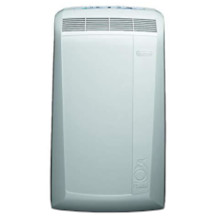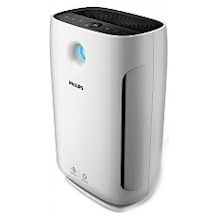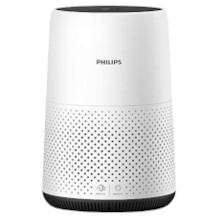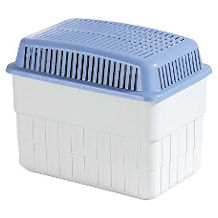Fan purchasing advice: how to choose the right product
- What you need to know
- By swirling the ambient air, fans create a cooling effect on the skin and provide a more comfortable indoor climate.
- Fans not only cost a fraction of the price of air conditioners, they are also better for people and the environment.
- In addition to axially ventilating floor, table and ceiling fans, there are also tangentially ventilating tower fans and rotorless fans.
- The effectiveness of a fan depends largely on the air circulation and the rotor diameter, which must correlate with the size of the room.
- If fans are used in the bedroom, the adjustability of the wind speed and operating volume are particularly important.
- Additional features such as an oscillation function, a remote control or a timer increase the ease of use.
The days are getting longer, the sun is gaining strength and temperatures are rising: From May to September, the heat in many private homes and offices is almost unbearable. Temperatures above 30 degrees Celsius quickly become a test of endurance. On very hot days, not a breath of air seems to move – an oppressive feeling. A prolonged stay in heated rooms without cooling is not just sweaty, but a strain on the circulation. The result: poor concentration, loss of performance and, in the worst case, heat exhaustion. A fan is the remedy. In summer temperatures, it brings a fresh breeze indoors to reduce the perceived temperature and make the hot spells at least a little more pleasant. A pleasant freshness is noticeable after only a short time.
Do fans actually cool the room?
The term fan is derived from the Latin word “ventilare”, which loosely translated means “to produce wind” – and that is exactly its function. Although a fan provides a noticeable cooling effect, unlike an air conditioner it cannot reduce the room temperature, but merely blows the existing air into the room and swirls it. Strictly speaking, the room temperature actually rises minimally through the use of a fan, as all electrical devices emit thermal energy, i.e. heat. Technically speaking, a fan is a current-driven airflow machine that works with rotating blades. The rotor blades, also known as impellers or propellers, suck in the air on their backsides and conduct it frontally into the room as a strong current.
We find the room temperature more pleasant in this air flow. This is mainly because the generated air meets the thin film of moisture on our skin that the body produces when it is hot. When it evaporates, it cools the surface of the skin, which is like a kind of self-cooling system. The more moisture evaporates, the greater the cooling effect. The air flow of a fan additionally boosts this cooling effect by constantly exchanging the air masses directly above our skin, thus providing a refreshing feeling. In other words, it makes use of the evaporative cooling effect of the sweat on the skin.

Should I cool it or should I blow?
Unlike in the USA, for example, air conditioners are rather rare in this country. Especially in small to medium-sized rooms, fans are an inexpensive and at the same time efficient way to provide cooling on hot days. Not only are their initial costs lower, but the follow-up costs are also lower because they consume less electricity. If, for example, a 1,000-watt air conditioner runs for eight hours a day, consumers will incur costs of 2.39 euros, whereas the same operating time with a fan would only cost just under 12 cents.
Compared to air conditioners, they provide a pleasant indoor climate not only in summer but also in winter. So, contrary to what is often assumed, fans are not a purely seasonal purchase; instead, they are an asset throughout the year. The permanent air circulation favours ventilation especially in summer when the windows are open. In winter, the units distribute the heating heat evenly to all corners and help to reduce the humidity in the room. In this way, consumers not only prevent mould from forming in cold, damp corners, but also save on heating costs. While air conditioners are commonly thought to cause infections such as colds or bronchial and sinus problems, fans are kinder to health – provided you take care not to expose yourself directly to the airflow for long periods of time. Most models are also lightweight, space-saving and mobile.
For those who do not like air-conditioning for the reasons mentioned above, who cannot install it for technical reasons or who cannot afford it or do not want to, a fan is a thoroughly welcome helper in a pinch. But not all fans are the same: a few years ago, there was only the classic design with a large, round propeller, but today numerous new models are conquering the market. The devices differ not only in terms of design, but also in terms of air circulation, volume and features. So that you don’t get lost in the mass of fans, we will help you find a model that perfectly suits your requirements.
From the table to the ceiling: an overview of the construction types
Think carefully in advance about where you want to place your new fan, how often you will use it and what requirements you have for the device. Fans are available in various designs that differ not only visually but also in terms of their effectiveness. Roughly speaking, the air whirling fans can be divided into three types, which differ substantially in the way they ventilate, namely
- Axial fans, including floor fans, floor and table fans, ceiling fans and mini and USB fans,
- tangential fans, i.e. tower fans, and
- rotorless fans.
Each type has its advantages and disadvantages. While a ceiling fan is mainly suitable for large rooms and a table fan is classically used at the workplace, a mini fan can be stowed in a handbag when travelling. So first and foremost, it depends on the size of the room and the space available in the room in question: A table fan would be ineffective in a room with an area of 70 square metres. So a larger and, above all, more powerful model is needed here. Often, however, the necessary space is lacking, which in turn makes the ceiling fan interesting as a space-saving alternative. We present the most common models below.
Axial fans: Wind power through propellers
Axial fans are the most common type. The rotary motion of the rotor blades runs parallel (axially) to the air flow generated. In their mode of operation, they are similar to aircraft and ship propellers. The decisive advantage of the axial design lies in its compact dimensions in relation to the volume of air conveyed. In other words, this type of model is capable of shovelling a particularly large amount of air. In addition, they are more flexible in their orientation, i.e. they can usually be swivelled vertically and horizontally.
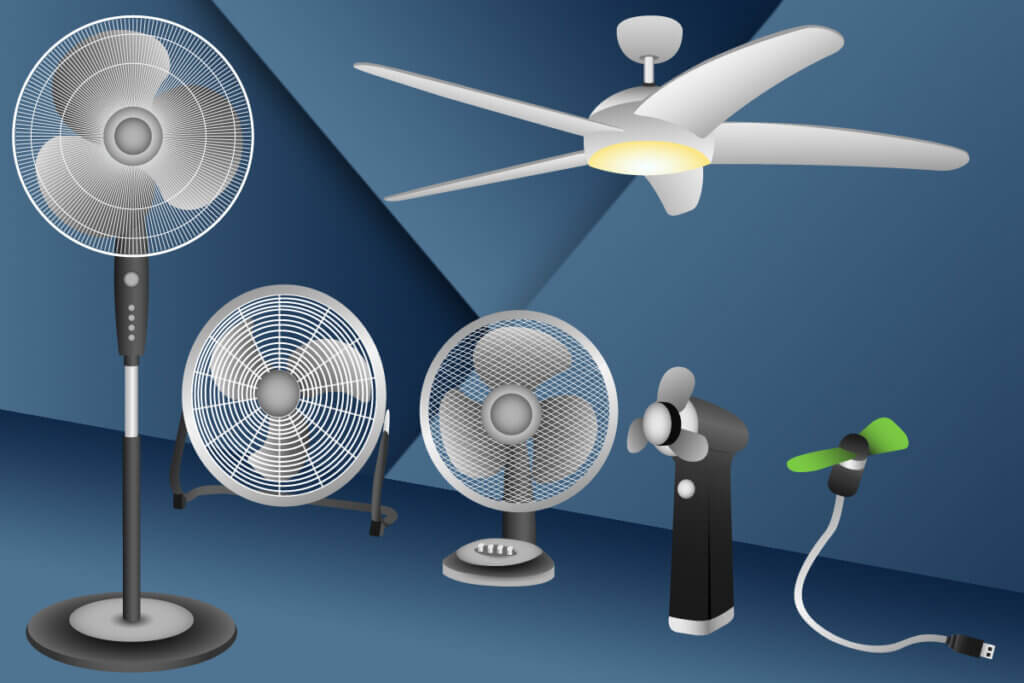
Pedestal fans: The classics
With their simple design, floor fans are the classics par excellence. They consist of a robust stand or stand ring, a telescopic rod that ensures individual height adjustment, and a rotor head that is fitted with a metal grille for safety reasons. Non-slip feet ensure a safe stand, otherwise there is a risk of tipping over. The rotor is arranged vertically and has a diameter of about 40 to 50 centimetres. Compared to other types, floor fans require a larger footprint. However, they owe their size to the powerful motor that ensures continuous cooling. Of all types, pedestal fans make the most noise for their power, i.e. they have the highest ventilation capacity.
Caution, risk of injury!
Since the rotor blades turn very quickly, it can be quite a painful experience if a finger gets caught between them. Especially households with children should make sure that the fan is equipped with a protective grille. To clean the blades, however, the grille should be removable in any case.
When it comes to volume, however, consumers should not be too sensitive. The more powerful motors produce a noise level of about 50 to 60 decibels. This makes floor fans rather unsuitable for the bedroom. An exception is the Quiet Set by Honeywell, which operates extremely quietly at just under 40 decibels. Good floor fans also offer an adjustable tilt angle and an oscillation mode, also known as a swivel function, so that the air flow reaches the entire room.
If you are looking for a device that you can use in one room for a longer period of time, but that can also be conveniently moved to another room if necessary, a floor fan is a good choice. It can be positioned anywhere in the room and can therefore be used flexibly. Since floor-standing units cover a wide area, they are also suitable for large rooms. However, open-plan offices in particular tend to use the mobile, space-saving table fans.
Advantages
- Very powerful
- Long reach
- Individual height adjustment
- Various alignment options
- Flexible use
- Lightweight despite its size
Disadvantages
- Large space requirement
- High noise level
- Sometimes danger of tipping over
Floor fans: Ventilation from below upwards
As the name suggests, floor fans are placed on the floor so that they blow the air upwards. The devices make use of the physical law that warm air rises while cold air sinks. As they take in the colder ground air, the cooling effect is magnified. They also use a rotor to generate the air flow, but they do not have a swivelling leg and thus no horizontal rotation. In terms of flexibility, users have to make certain sacrifices. However, their lateral swivel joint at least allows them to be adjusted upwards, downwards or straight ahead.
Visually, they are more like table fans than floor fans – with the difference that their stable base enables them to stand on the floor. Standing on the floor minimises the risk of whirling up documents that are on the desk. The other side of the coin: on the floor, they sometimes become a tripping hazard.
Thanks to their compact dimensions, floor fans are versatile, whether in the home, office or workshop. Since they are very light, they can be easily repositioned. Nevertheless, they generate a strong air flow that “cools down” even larger rooms to pleasant temperatures and mixes the air evenly. As with the floor fan, however, the strong air flow is also associated with a certain volume ( up to 70 decibels).
Advantages
- Stronger cooling effect due to floor placement
- Powerful despite compactness
- Flexible use
- Compact and lightweight
Disadvantages
- No swivel function
- More noise
- Potential trip hazard
Table fans: A cool head at the workplace
The compact, lightweight table fans are mobile and portable. They can be set up wherever a little cooling is needed – from the office desk to the workbench. They can be placed on the living room, kitchen or desk to save space and cool at chest or head height as needed.
The small siblings of the floor fans consist of a short base, a rotor basket and several small rotor blades. Usually, different speed levels can be set. In addition, the fan head is ideally capable of oscillation. However, they are not height-adjustable.
Table fans are primarily suitable for selective ventilation. Due to their design, their ventilation performance is comparatively weak. Their range is therefore limited to the immediate vicinity in front of the unit. They are the ideal alternative to floor fans if you do not want to create a draught in the entire room, but only want to feel a cooling air flow at your desk to make your office day more bearable on hot days. However, since the unit is particularly close to a person, the wind force should not be too strong anyway. In offices, this not only prevents a stiff neck or dry eyes, but also documents on desks from blowing away. In addition, their weaker performance is accompanied by a low noise level of 30 decibels on average.
Advantages
- Compact and lightweight
- Space-saving
- Adjustable tilt angle
- Low noise
Disadvantages
- Weak performance
- Limited reach
- Not height adjustable
Ceiling fans: For economical continuous use
While ceiling fans are widespread in tropical regions and the USA, they are rarely found in Europe. They are permanently mounted on the ceiling and use large rotor blades that rotate around a vertical axis and generate an air flow that leads towards the floor. Thanks to their large span combined with their elevated position, they are extremely effective even at low rotation speeds. Ceiling fans promote air circulation in the room and in this way help to swirl and dissipate stuffy, overheated air. By distributing the air evenly from above in the room, a cooling effect is created. Their diameter of 70 to 300 centimetres should be chosen depending on the size of the room. Because they are mounted on the ceiling, they do not take up any space and are not an obstacle in the living area. However, ceiling fans must remain in place, whereas other models can be moved quickly and easily. In addition, they are more difficult to install and clean than floor-standing models.
In larger rooms, ceiling fans are a good alternative to floor units because their air circulation capacity is more effective. Fewer blades here mean greater air circulation, as they move larger volumes of air without taking away each other’s rolling work. However, they operate more quietly with a higher number of blades. This is due to the fact that the blades always run in the slipstream of the preceding blade and thus do not cut the air so sharply. Depending on the operating volume – usually between 40 and 50 decibels – ceiling fans are often installed for continuous use in bedrooms, as they do not produce the usual draughty feeling. A protective grille is not necessary because the rotor blades on the ceiling do not become a hazard. For this reason, ceiling fans are particularly suitable in households with children or pets.
Most ceiling fans are capable of moving the air downwards or upwards (forward and return), which is why they can also be used in winter. In the reverse function, they push the upward rising warm air back down and distribute it in the room, which means that users ideally need to heat less. Ceiling fans are also often equipped with a lamp device as practical two-in-one solutions.
Advantages
- Optimal air circulation
- Very efficient
- Space-saving installation on the ceiling
- Saves heating costs thanks to the return function
- Low operating noise
- No risk of injury
- Available in combination with lamp
Disadvantages
- Location-dependent
- High installation costs
- Difficult to clean
Tangential fans: The slim towers
Tangential fans, also called tower fans or column fans, are now the second most frequently purchased fan variant. They do not work with rotors, but draw the air in through a wide, louvred drum at the rear and discharge it evenly through a slot at the front. Since they distribute the air over the entire height of the fan, models of this design generate a particularly high air circulation. In other words, they move large volumes of air. Tangential units are generally more powerful than axial units. However, their range is rather limited compared to other fan types. Consequently, in rooms larger than 20 square metres, no cool air reaches the other side of the room.
Most units have numerous adjustment options. The model T-VL 5531 from AEG, for example, provides three speed levels for individual adjustment, from a light breeze to a strong draught. On a low setting, tower fans are very quiet with about 35 decibels in operation, which is why they are also used in bedrooms. Some models are also equipped with a swivel function so that they can supply an entire room with a cool breeze. However, unlike floor fans, they are not height-adjustable.
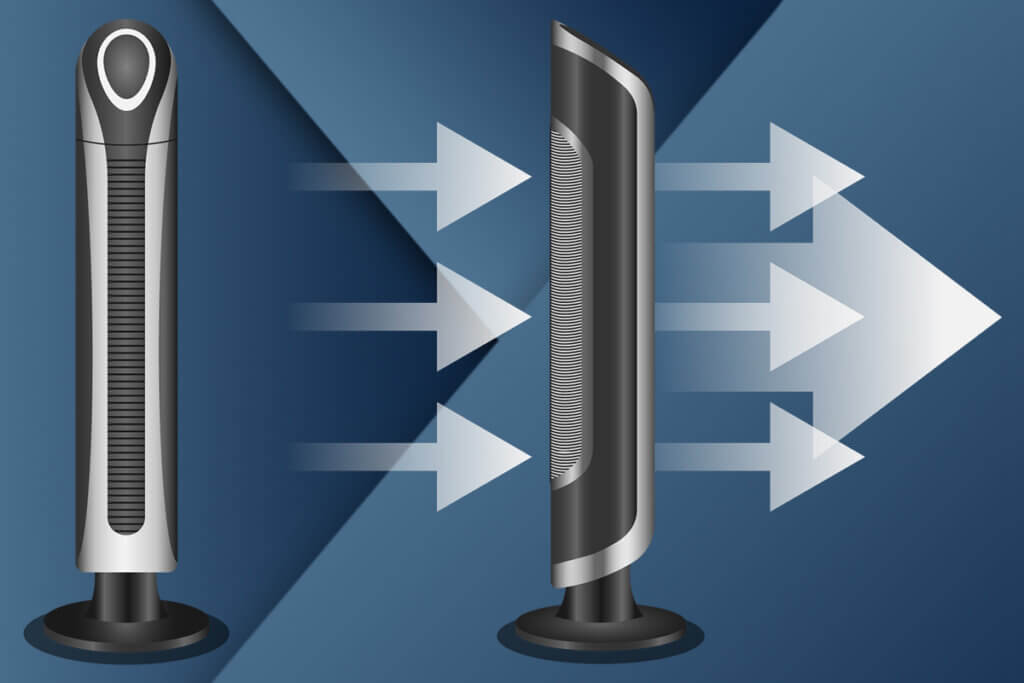
Tower fans are often characterised by a modern, elegant look. Thanks to their slim column design (between 50 and 120 centimetres), they are a good alternative for rooms where there is not much space. For example, they fit perfectly into gaps between two pieces of furniture. The straight design also ensures an extremely secure stand.
Advantages
- Particularly powerful
- Large ventilation area
- Space-saving design
- Numerous adjustment possibilities
- Hardly any operating noise
- No risk of injury
Disadvantages
- Not height adjustable
- Low range
Rotorless fans: Bladeless, flexible, whisper-quiet
With the new rotorless fans, a motor installed in the base does the work that is usually done by the rotors. The ambient air is sucked in by the motor and passed over the fan ring. In this ring, the air is accelerated in a kind of air duct and blown back into the room through an opening. Compared to other models, rotorless fans have several advantages: For example, injuries caused by rotor blades are ruled out. Their swivel function covers even larger rooms effortlessly. And the infinitely variable control is also particularly convenient.
The first rotorless model, the Air Multiplier, was launched by Dyson in 2010. It consists of a narrow base and a ring. A fan with rotor blades is hidden in the base. This sucks in the air and releases it to the outside via a slot that runs through the entire round housing. By forcing the air through the ring with pressure, an even, 15 times stronger air stream comes out. Strictly speaking, rotorless fans do have a rotor, but it is not visible. Due to the complete encasing of the rotor and the small air blower, they are much quieter than other models. However, this functionality also has its price (300 to 600 euros).
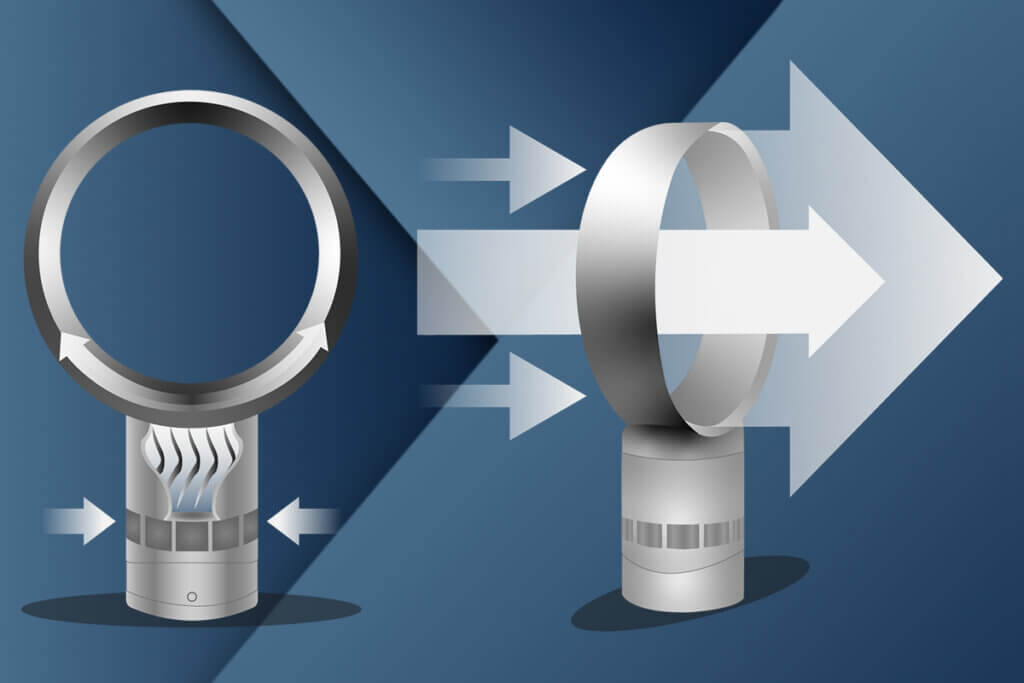
Mini fans: refreshment on the go
Mini fans can be divided into two categories: battery-powered hand fans and USB fans. Hand fans are perfect for on the go, be it on the train, at the campsite or on a shopping trip. USB fans, on the other hand, are connected to the PC or laptop. Both versions are so small that they fit in almost any pocket. They are often equipped with extras such as LEDs or an integrated atomiser. The handy fans can be used flexibly, but their air flow is rather weak, which is why they are only suitable for spot cooling of small areas such as the face.
What is important when buying a fan?
From a gentle breeze to a powerful hurricane: thanks to their diversity, fans offer numerous ways to circulate the room air. The power in watts is by no means everything when deciding what to buy. What is more important is the optimal interplay between the number and diameter of the rotor blades, air circulation and motor power. These factors in turn have an impact on the operating noise level. The criteria to consider when buying a fan are discussed below.
How many speed levels should a fan have?
On some days you prefer a gentle breeze, on others it can’t be windy enough for you? If the fan has several speed levels, the airflow intensity can be varied. This means that users can set the airflow to be stronger or weaker depending on their needs. The more levels there are, the more individually the device can be adapted to one’s own needs to provide the perfect amount of cooling. While most commercially available units have at least three switching levels, high-quality models come with up to 25 switching levels. The number of steps also depends on the type of fan. For example, smaller fans generally have fewer setting options than large floor-standing or tower fans. The power capacity also has a significant influence: the more watts, the more speeds. The control functions either via buttons or a rotary wheel on the unit, a display or a remote control.
For use in the bedroom, a so-called “night mode” or “sleep mode” is useful, in which the fan turns particularly slowly to reduce the operating volume. The so-called “Breeze Mode” simulates the gentle breeze of naturally blowing wind by alternately increasing and decreasing the strength of the air flow. AEG calls this function “nature mode” on its VL 5668 S model. Here, the unit automatically switches between the speed levels slow, medium and fast. In this way, it imitates the natural wind.
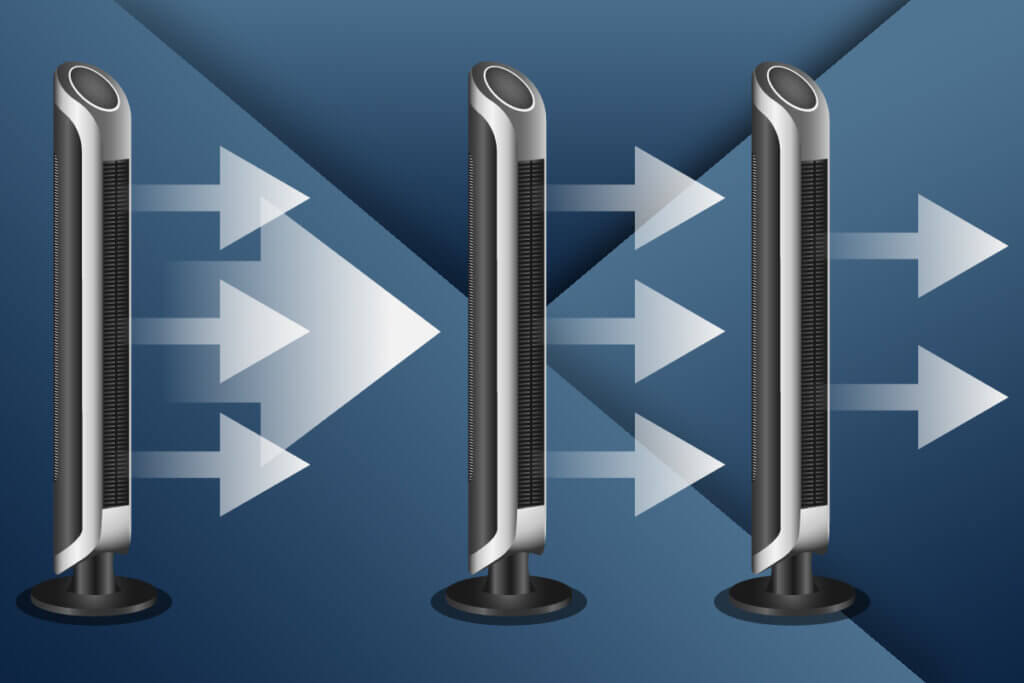
How high should the air circulation be?
The factors power and air circulation are often confused with each other. The power of most fans ranges between 15 and 75 watts. However, there are also devices on the market that have over 2,000 watts. Mini fans, on the other hand, often have only 2.5 watts. However, a high wattage does not necessarily mean a high air circulation, which is why prospective buyers should not only look at the mere power. The effectiveness of a fan depends much more on the air circulation: The higher this is, the more air is circulated. The value of air circulation, also known as airflow volume, indicates how many cubic metres of air can be circulated per hour. While a 20-square-metre room with a ceiling height of about 2.5 metres is already well served by a fan that circulates 200 cubic metres per hour, units with an air circulation of at least 1,200 cubic metres per hour are needed for office use.
Small fans have an air circulation of about 600 cubic metres per hour. High-quality units from Honeywell or Dyson circulate up to 2,000 cubic metres of air per hour. Rowenta fans even manage 4,800 cubic metres per hour and are thus ideal for particularly large rooms.
The right placement
Make sure the unit is on a level surface so it can’t tip over. If the back of the fan is against a window, it may allow cooler outside air into the room, making it easier to ventilate in summer. Ideally, point the fan towards the ceiling, because this way it circulates the warm air much more efficiently. However, you should never place the unit in such a way that you are permanently in the direct air flow. This can lead not only to hypothermia but even to conjunctivitis.
Which rotor diameter is suitable for which room size?
The diameter of the rotors must be matched to the size of the room, because this ultimately determines the air circulation. For an area of about 25 square metres, for example, you need a fan with a rotor diameter of at least 30 centimetres. Larger rooms, on the other hand, are better served with a rotor diameter of at least 40 centimetres. For selective use, for example at the desk, you are already well served with a diameter of 12 centimetres. For fans without rotors, such as tower fans, the orientation is primarily based on the value of the air circulation achieved.
How many blades should the fan have?
The number of blades has a decisive influence on the air performance or the air circulation of the unit. The more blades the fan has, the less power it needs to generate the same amount of wind. The lower power consumption in turn leads to lower energy consumption. Ultimately, the decisive factor is the interplay of size, shape and orientation angle. Larger, slightly curved rotors mounted at an angle to the axis ensure the highest efficiency.
How loud is a fan?
Noise is one of the most important purchase criteria, as the device is usually located in close proximity to the user and is in operation for a longer period of time. After all, a fan should provide a breath of fresh air without being annoying. A loud fan can have a negative impact not only on a quiet evening watching TV in the living room, but also on concentration in the office. The noise level is particularly relevant when used in bedrooms, as a high noise level can impair sleep. The volume of a fan averages between 30 and 80 decibels. For comparison: 30 decibels is roughly equivalent to a whisper, 65 decibels to a group conversation and 80 decibels to traffic noise. However, a noise level of 30 to 40 decibels should generally not bother even noise-sensitive people.
The decisive factor for the noise level is primarily the selected speed level, but the design also has an influence on the noise generated by the unit that should not be underestimated. Pedestal fans are considered to be particularly loud; significantly quieter are the narrower tower fans and the more compact table fans. Basically, the faster the rotor blades, the louder the fan. However, since the speed can usually be regulated individually, the operating volume can also be adjusted. Ideally, the fan produces little noise but still a lot of wind.
How much energy does a fan consume?
In contrast to air conditioners, which are true “power guzzlers”, fans require little electricity. This makes ventilating with a fan the more cost- and energy-saving cooling option. The power consumption of a fan depends primarily on its size and performance: The more powerful the unit, the more energy it requires for operation. On average, the power of a fan is 50 watts per hour. To calculate the power consumption, use the following formula: Wattage x 29.88 : 1,000. The value 29.88 is the current average electricity price in cents per kilowatt hour (as of August 2019). In our example case, the calculation is as follows: 50 x 29.88 : 1,000, which results in a price of 1.49 cents per kilowatt hour. For ten hours of operation, consumers therefore pay 14.9 cents. So even in continuous operation, a fan would not cause an exorbitant electricity bill.
Of course, it always depends on the level at which the unit is running. Usually, the value given by the manufacturer in watts corresponds to the maximum output. Due to their design and performance, table fans and tower fans are generally more energy-efficient than floor fans and pedestal fans.
What does a good fan cost?
Depending on the model, the cost of a fan varies considerably: while a hand fan is available for as little as two euros, a high-quality ceiling fan costs up to 500 euros. Although there are always cheap devices from discounters, these are not recommended because they are usually quite power-hungry. In the long run, it pays to invest a few euros more in a fan. The price depends, among other things, on the performance, but also on the design:
- Hand fan: approx. 2 to 5 euros
- USB fan: about 5 to 15 euros
- Table fan: approx. 20 to 100 euros
- Pedestal fan: approx. 30 to 100 euros
- Tower fan: approx. 60 to 300 euros
- Ceiling fan: approx. 80 to 500 euros
Dyson fans generally spend more. Those who don’t want to do without extras such as a timer or remote control also have to reckon with higher costs.
Features for perfect comfort
Which features the fan should have depends on individual requirements. While some do not want to do without extras such as a smart home connection, this equipment is less relevant for others. Please note that although additional features provide extra comfort, they are also reflected in the price.
What control options are available?
With various control options, users can programme their fan in the way that is most convenient for them.
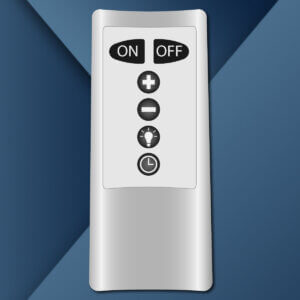
Remote control
A floor fan with remote control is not a must, but it can prove to be quite practical, especially in large rooms. First and foremost, it offers added convenience. Users do not have to get up from the couch or walk awkwardly through the office. With ceiling fans, control via remote control is essential. Depending on the device, a remote control offers various regulation options, from switching on and off to adjusting the air flow. The remote control should have a range of at least ten metres. When it is not needed, it can usually be stored in a small compartment directly in the fan.

Timer
A fan with a timer can be set to reduce the power after a certain time or to switch off completely. With a timer, users can also preset the fan to turn on just before they get up or go to the office. Since fans are designed for continuous operation, they can in principle run day and night. However, it makes sense to set a timer for the night, as temperatures cool down at night anyway and a continuous draught of air can cause headaches and neck pain. This allows you to fall asleep in the air stream of the fan, but after a preset number of hours, the fan switches off automatically. The bonus: you save on electricity costs.

Pull and wall switch
Ceiling fans with pull switches have an almost antique flair. They are attached directly to the fan and operated manually. The user controls the switching on, the setting of the rotation speed and other extras via the pull switch. Usually, three speed levels can be set. For example, one pull sets the motor in motion, further pulls control the running levels. If lighting is available, it can usually be switched on and off via the pull switch. If necessary, users can also regulate their ceiling fan with a wall switch. In addition, a light switch is often integrated. Both switching technologies have an advantage over remote controls that should not be underestimated: they do not get lost.

Smart Home
In the meantime, there are more and more models that can be activated or regulated remotely via an app by being integrated into the wi-fi. With Alexa or Google Assistant, voice control is even possible. A fan with smart home function reacts, for example, by adjusting the air exchange when the user opens a window. Modern devices also adjust the light colour to the respective time of day. A smart-home connection therefore not only increases comfort, but can also reduce energy costs. Those who do not want to part with their old fan can usually even retrofit it by installing a wi-fi socket as an intermediate plug.
What features do fans have?
In addition to air turbulence, fans often have other functions. Features such as an oscillation function or a rewind bring numerous advantages.

Oscillation function
Since a fixation of the airflow on the user can quickly cause neck and back pain, a swivel function, also called oscillation, is recommended for fans. In this case, the unit rotates mechanically from side to side. The angular range of oscillation is 75 to 180 degrees, depending on the model. Due to the increased effective range, the air is distributed more evenly and efficiently throughout the room. If necessary, users can usually deactivate the oscillation. An oscillation function is basically only reserved for fans with a stand. Tower fans can also oscillate, but with them not only the head but the entire body oscillates. Placed in a corner of the room, they distribute the air best.

Forward and return function
(Ceiling) fans are not only a useful purchase in summer: while they cool in the hot months, they warm in winter – provided they have a return function in addition to the usual forward function, sometimes also referred to as left and right rotation or summer and winter mode. In summer mode, the airflow is directed directly downwards. In winter mode, the direction of rotation is reversed, i.e. the air flow is directed to the ceiling. This ensures, especially in rooms with a ceiling height of less than 2.80 metres, that the heating air rising upwards is swirled with the rest of the room air. In this way, the fans ensure temperature equalisation as well as improvement of the room air.

Lighting
Ceiling fans with integrated lamps are a practical substitute for separate room lighting. With a combination unit, you enjoy not only a fresh breeze but also pleasant light. The lighting creates a homely ambience in the room. For use in the study, a bright light is recommended; for use in the living room or bedroom, the light should ideally be dimmable and controllable via a remote control. Alternatively, a wall switch with light function is a practical option. Make sure that the light bulbs are LEDs, as they have a longer service life. This means they are not only easy on the wallet, but also on the environment.

Spray
Want a fresh sea breeze? Fans with cooling use an integrated water system through which they distribute fine water droplets – up to 300 millilitres per hour – to their surroundings. Since the droplets are atomised microscopically small, there is no wetness, but an increased humidity. The actual added value lies in their cooling effect: the temperature appears up to ten degrees cooler. The spray mist that can be switched on is refreshing and improves the room climate. A three-litre water tank lasts for up to twelve hours. The spray mist also binds house dust, which is particularly interesting for allergy sufferers. Outdoors, it also keeps insects away. Often, flavourings can even be added.
Other useful features of a fan:
- Height and tilt adjustment: Most models, with the exception of fixed ceiling fans, allow height adjustment (between 75 and 130 centimetres) and tilt adjustment so that the unit blows at an angle upwards or downwards.
- LED display: A backlit LED display, ideally with indoor temperature display, and a self-explanatory symbol display facilitates operation.
- Castors: With four castors, the fan can be easily moved to another room or even to the terrace, turning it into a mobile wind machine. Often the castors are included in the delivery and can be mounted optionally.
- Carrying handles: Carrying handles ensure uncomplicated transport. Users can set up the fan wherever they need it at the moment.
Image 1: © Monika Wisniewska / stock.adobe.com | Images 2-13: © FinalCheck

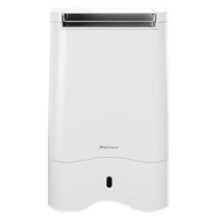
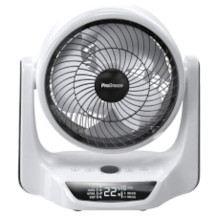
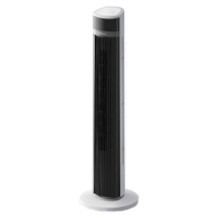

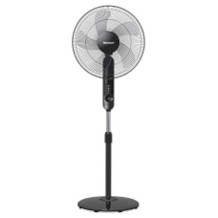
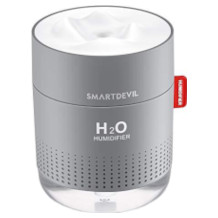






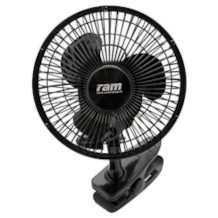
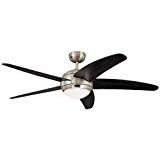


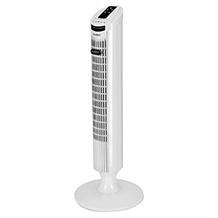
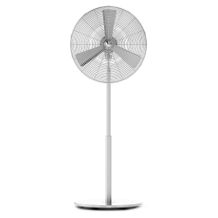
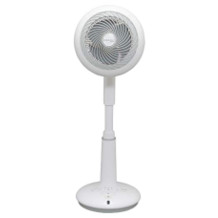
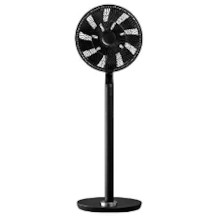
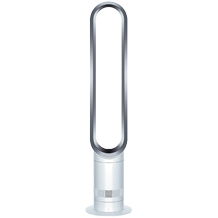

 18,456 reviews
18,456 reviews












